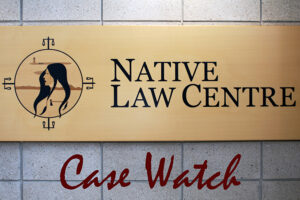Motion dismissed. The applicants have failed to meet the test for an interlocutory injunction against sustainable forest licence holders.
The applicants that operate Camp Eagle Nest, a not-for-profit corporation, seek an interlocutory injunction preventing sustainable forest licence holders to stop immediately any cutting, road building, or aerial spraying of herbicides on lands promised for survey by treaty in the Benny area. The Camp develops and delivers arts, wilderness education and Anishnawbek cultural and spiritual training sessions that improve First Nations cultural literacy, and also delivers employment training for First Nations youth and families.
The Atikameksheng Anishnawbek First Nation [“AAFN”] Reserve is located adjacent to the city of Sudbury and is outside of the Spanish Forest. In addition to rights to hunt and fish held under the Robinson-Huron Treaty, AAFN asserts that it has traditional territory rights in the area of Benny, within the Spanish Forest. Sagamok Anishnawbek First Nation is also a party to the Robinson-Huron Treaty, and also asserts traditional territory rights in this same area.
The three part test for an interlocutory injunction is set out as follows: 1) the applicant must demonstrate a serious question to be tried; 2) the applicant must convince the court that it will suffer irreparable harm if the relief is not granted; and 3) the balance of convenience must favour the applicant (RJR-MacDonald Inc v Canada, [1994] 1 SCR 311). The remedy of an injunction is an all-or-nothing solution. Either the project proceeds or not.
By contrast, the duty to consult assists in balancing Aboriginal interests and societal interests by reconciling Crown interests with Aboriginal interests. The jurisprudence makes it clear that in disputes involving First Nation peoples and the protection of First Nation culture and heritage, there is a duty to consult and to accommodate the concerns of First Nation peoples wherever possible (Haida Nation v British Columbia (Minister of Forests), [2005] 1 CNLR 72 [“Haida”]). The Supreme Court of Canada makes it clear in Haida that the duty to consult is paramount, but not the duty to agree.
Forest management plans for the removal of timber and the sustainability of forests are created after a long process of consultation and negotiation with stakeholders and people who would be directly affected. The consultative summary submitted to the Court is detailed and extensive. In this matter, there is overwhelming evidence that the duty to consult has been met by the Ministry of Natural Resources and Forestry in attempting to accommodate the concerns of the First Nations Peoples in the Spanish Forest Management Plan in and around the area of the hamlet of Benny. Even applying a low threshold, that threshold has not been met to establish that there is a serious question to be tried.
The applicants have not been specific about the harm that they would suffer if an injunction is not granted. They spoke in terms of generalities. Generalities do not satisfy the degree of proof required to establish irreparable harm. The Court concluded on the evidence and the facts of this case that the applicants have failed to establish all three requirements for an interlocutory injunction.
Further, a First Nations band may authorize an individual to represent its interest for the purpose of asserting the rights of the band, but that was not the situation in the case at bar. The applicants were not authorized by the AAFN to represent or speak for the band in its dealings with the Ministry of Natural Resources and Forestry concerning the Spanish Forest Management Unit in or around the hamlet of Benny. On the contrary, the AAFN was very much involved in the consultative process as seen by the consultative record. The applicants asserted that as First Nations people they are entitled to be consulted separate and apart from the AAFN. The duty to consult exists to protect the collective rights of First Nation peoples and therefore the duty to consult is owed to First Nation groups as a whole and not to individual members of the band (Behn v Moulton Contracting Ltd, 2013 SCC 26).



